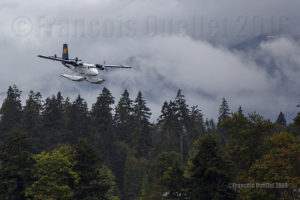
It looked like it would be an average day for a photography session at the Vancouver Harbour. The sky was quite ordinary, which means totally cloudless. But around noon, a new and more humid air mass made its way in British Columbia and rapidly the blue sky was replaced by clouds and precipitations. At the same time, the high intensity light that was prevailing around noon suddenly took more acceptable levels for photography.
Pilots of different bush floatplanes like the Twin Otter (DHC-6), Turbo Otter (DHC-3T) and Beaver (DHC-2) had to deal with the sudden weather deterioration in order to complete the daily planned flights. But one man’s loss is another man’s gain. For aviation photography, low clouds and light intensity meant that the pictures would be more interesting.
The photo above was taken with a Canon 5DSR full-frame DSLR camera equipped with a Canon 70-200 f2.8L IS II USM telephoto lens. In order to capture the moving propellers, I had to set a low shutter speed. The scene was then cropped to avoid visual distractions. The 50.6 megapixels full-frame sensor of the Canon 5DSR facilitates cropping when it is required.
In the foreground, there is a Harbour Air Twin Otter floatplane (C-GQKN) approaching to land in the Vancouver Harbour. In the background, far away and in the superior right corner of the photo, the pilot of a Turbo Otter floatplane also deals with worsening weather while ensuring that he maintains a visual contact with high ground obstacles surrounding the harbour.
Click on the following link for aviation photography on my blog.